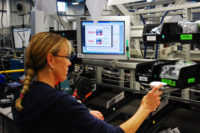Subassembly production launches are becoming increasingly challenging for Tier I suppliers. Supply chain data inputs are expanding, and variables are changing more frequently. Major industry technology transitions are one macro trend adding supply chain complexity. For example, General Motors will continue to produce internal combustion engine vehicles alongside new electric vehicles until at least 2030, which will exponentially grow both the number of end-products and parts. Further, our more dynamic world is hampering launches; headwinds ranging from tariffs to recessions are causing us to change our supply chain plans.
To uncover specific actions that manufacturers can take to accelerate new subassembly launches, my company, IndustryStar Solutions LLC, conducted a series of in-depth interviews. We teamed with Sime Curkovic, Ph.D., professor of management at the Haworth College of Business at Western Michigan University to craft and administer a 68-question survey that was completed by 250 professionals across 25 industries. Participating companies included Denso, Cooper Standard and Inteva.
Our research produced the following findings:
- More than 70 percent of supply chain organizations reported that product production cost, time to market, quality and technical performance were improved by setting earlier launch performance targets.
- At the same time, only 51 percent of supply chain organizations are measured against established performance targets for expected contributions to new product development.
In summary, tremendous waste exists between the development of a new product and supporting subassemblies and production launch. Unpacking the data further, establishing targets empowers cross-functional teams to better drive toward a common goal. However, the question remains, how do we empower our teams to efficiently set and track earlier launch targets in the face of increased complexity?
Capturing Offline Supply Chain Data is Key to Managing Launch Complexity
During the 1970s, our supply chains took a step forward as materials requirement planning systems allowed us to track inventory, order materials and schedule production. In the 1990s, we took another step forward as enterprise resource planning (ERP) software allowed us to manage end-to-end operations, from production to logistics to quality.
Sadly, these steps equated to little more than a crawl. ERP systems are broken and do not handle the complexity of today’s global supply chains. ERP systems capture a single linear Plan A that breaks as soon as variables change. Unfortunately for CEOs and supply chain leaders, most of the input data that goes into forming supply chain plans is offline. Data is stored in team members’ heads and spreadsheets, causing increased workload, analysis delays, and in some cases, supply disruption when change inevitably occurs. Leaders need to capture this invaluable supply chain input data and leverage it to make faster supply chain decisions that consider multiple launch plans so they can thrive no matter what changes in the world.
Launch leaders separate themselves from laggards by their game plans and ability to manage change. Just as a talented group of college football players thrives under the right offensive game plan, so, too, do manufacturing professionals. Executing the right detailed game plan matters, since subassemblies are often complex engineered products that might contain dozens or even thousands of parts. The ability to adjust your game plan in the face of change is also key. Assembly parts range from purchased to modified to common off the shelf, all of which need to arrive at the right quality, cost, and time to launch production on time.
A single car has about 30,000 parts. The major subassemblies of an automobile include the body, interior, chassis, electrical, exterior and propulsion (engine, transmission, exhaust, fuel tank) systems. Do electric cars have less parts? In short, yes. An electric propulsion system is much simpler than one powered by an internal combustion engine (ICE), with fewer moving parts. There are only around 20 moving parts in an electric propulsion system, compared with nearly 2,000 in an ICE. Even as manufacturers push forward with new and innovative electric vehicles, there are still 1,000s of parts to manage. Many of these parts can create new challenges for engineers. Some of these parts, such as electronic subassemblies, require new skill sets to manage. There are roughly 10,000 unique parts in a Tesla Model 3, and any one of them can slow down the automaker’s important production ramp up.
Tracking the sourcing and progress status of thousands of highly engineered parts presents multiple work streams. Ensuring supplier compliance to engineering changes for early part builds and production ramp ups is another area that often expands launch timelines. Today, most companies have roughly 100 manual supply chain processes that slow production launches.
To solve these challenges, it’s important to avoid relying on manual processes where team members are required to analyze offline data to ensure launch success. Too many rely on manual tools like Microsoft Excel to run their day-to-day launch operations, such as organizing part commercial data, such as tooling status, quality checks and prototype shipments.
To date, this high-touch approach has been an accepted pain across the industrial sector. Often, a company’s ultimate launch success is predicated on hiring high-paid consultants to support prelaunch activities to avoid delays. Manufacturers largely throw people resources at launch workload spikes to track, process and report paperwork. To bring innovative products to market faster, more collaborative productivity tools are required.
As more and more technologies are incorporated into subassemblies, manually tracking critical key performance indicators (KPIs) is becoming increasingly challenging. KPIs such as costs for inbound logistics, maximum inventory and production packaging are common bellwethers. Digging deeper, initial targets for delivery lead time, inventory buffers and packaging pools can prove instrumental in both meeting KPIs and ensuring KPIs are the right metrics to pursue.
Developing a Launch-Winning Game Plan
You need an offensive game plan for success; nobody wants to be on defense. A plan for every part (PFEP) is your launch-winning game plan. A well-established lean tool, a PFEP is a material flow plan that includes data on every part number coming from suppliers and every finished-good SKU going to customers. It contains all the information necessary to make informed decisions about transportation, packaging, inventory, placement, ordering quantities and handling. An expanded “commercial bill of material,” a PFEP is used to track part data inputs (such as usage per assembly, standard packs and storage location) and output information (such as part hourly usage, buffer day count and maximum inventory) in one large spreadsheet. A well-designed and maintained PFEP significantly reduces material shortages, inventories, supply chain complexity and costs.
A PFEP can vary in the number of data points tracked, but are typically 35 columns across. Thus, for a 100-part subassembly, a PFEP can equate to 3,500 data inputs that need to be manually inputted. Many suppliers are striving to track additional data ahead of launch. Up to 120 data inputs are being established and tracked for additional KPIs, such as landed part costs, tooling progress payments and backup supplier lead time. Suppliers are then able to adjust their game plan throughout launch based on actual data, which increases the likelihood of meeting targets.
Although PFEP is a wonderful lean tool, it often loses momentum due to the individual manual maintenance effort required. There is a better play. Automated PFEP software allows you to scrap your Excel BOM while increasing the pace of your production launch. It gives you one central home for data on Plan A, as well as Plan B and Plan C.
Utilizing Software to Further Increase Launch Pace
Transitioning from a manual PFEP spreadsheet to automated PFEP software can reduce new product launch timelines by as much as a third through enhancing team productivity. Collaborative productivity software, like automated PFEP, allows concurrent viewing, editing, and sharing of data in real time, which empowers launch teams to accomplish more in less time.
Manual calculations for inventory levels, assembly costs and packaging weight are automatically calculated. Further, tedious reporting can be standardized at plants and automatically shared with headquarters to empower teams to spend less time creating reports and more time delivering results.
Digitizing incoming and outgoing supply chain data allows “big data” mining, which can provide insight for continuous improvement. Making automated PFEP software an integral part of your launch game plan can have a powerful positive effect on your pre- and post-product launch supply chain success.



